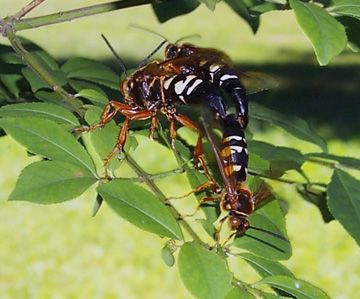Reproduction
Between mid-summer and early autumn, cicada killers (Sphecius
speciosus) begin to emerge from their nests after exiting
pupation. Males, usually surfacing a week before
their female counterparts, seek to claim territory within the
environment in preparation for the breeding season (Cornell
University-Master Beekeeper Program, 2004).
Once female cicada killers finally emerge, males attempt
to attract a partner for mating (Animal
Diversity Web, 2012).
In regards to the mating process, males patiently wait for females
to enter their territory.
Once a mate has been spotted within a particular male’s
territory, the male will fly after the female in order to attempt in
mating. If mating does occur, it most often takes
place while airborne. Additionally, during the
process, the couple will plummet through the air, hitting the ground
together (Dambach and Good, 1943).
This process may attract the attention of other males; however, the
mating process, itself, has already been completed. At
this point, the male and the fertilized female separate apart.
The female works in preparation for her offspring, while the male
may continue to attempt in finding additional mates until
approaching death (Animal
Diversity Web, 2012).
After fertilization, the female wasps actively work their way into
the ground. They proceed to create cavities
within the soil that will serve as a nest for the expected offspring
(Animal Diversity Web, 2012).
Once the nest is complete, a female will target and hunt wild
cicadas to provide a host for their offspring. At
least one cicada is placed within every nest; however, additional
cicadas may be added as a food source for when larvae hatch (Smithsonian
Institution, 1999). In general, female
offspring are given preference to additional cicadas (Encyclopedia
of Life, 2012). As a result, many believe
that this preference partially accounts for their larger size (Hastings
et al., 2010).
Unlike many insects, the female cicada killer lays only one egg
during reproduction (Oklahoma State
University Entomology, 2012). Once laying its
egg inside the host cicada, the female wasp patches the nest along
with any additional cicadas. Within two to three
days, the egg within the cicada hatches, giving rise to a larva that
proceeds to consume its host. For approximately
two weeks, the larvae will feed on its host as well as any other
cicadas until entering pupation (Smithsonian
Institution, 1999).
Meanwhile, the parent generation, after providing for their
young, dies off after reproduction around the month of September,
only living for a little more than one year.
Pupation rounds out the final turn of the
cicada killer life cycle. The process lasts
approximately 10 to 12 months and is critical for the development of
the larval wasps. While still in their nests, the
larvae will spin and suspend themselves within silk cocoons, which
provides a basis for their transformation. As
stated above, the wasps will then exit pupation and emerge from
their nests in the following summer months (Smithsonian Institution,
1999).
Home

